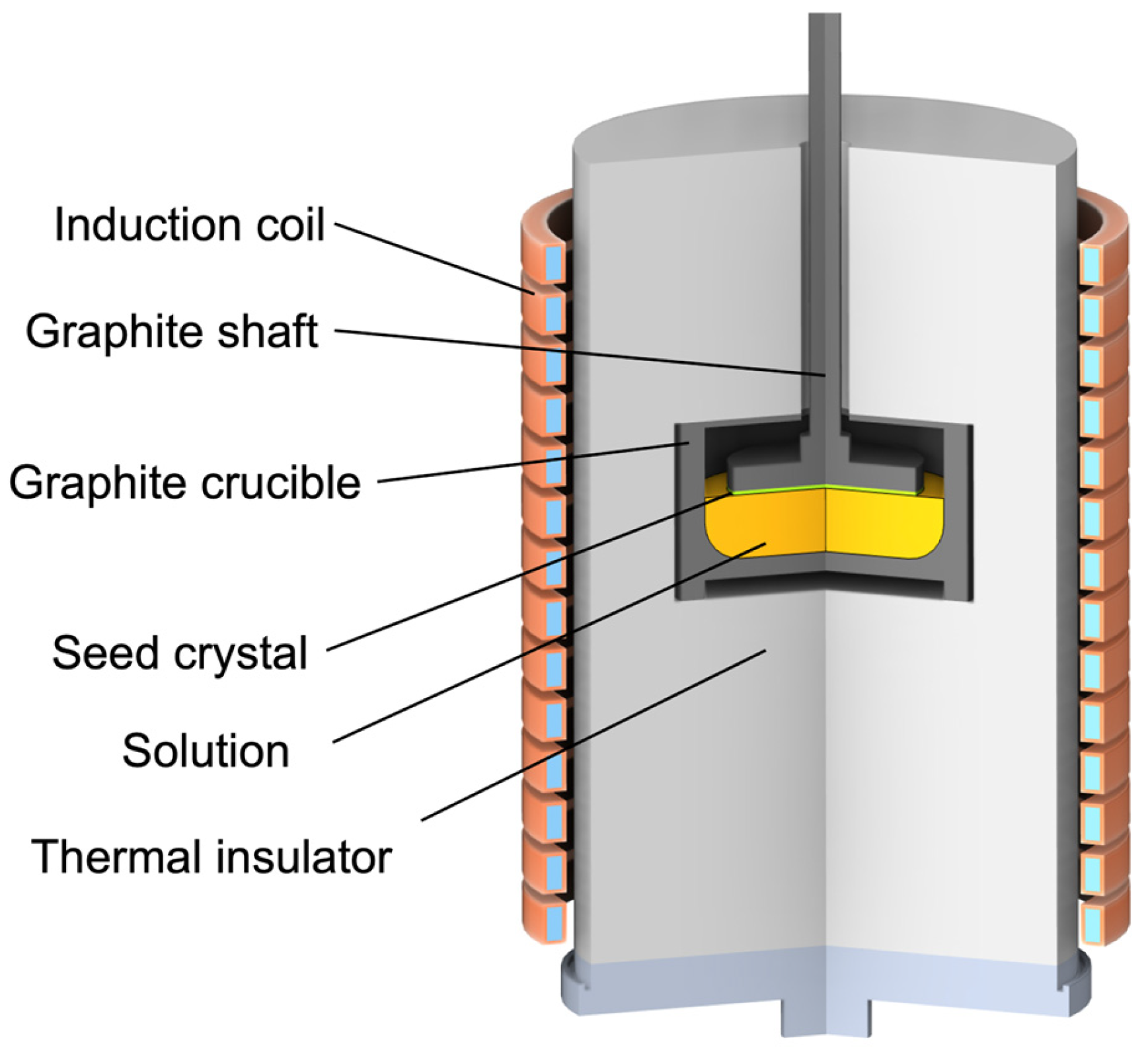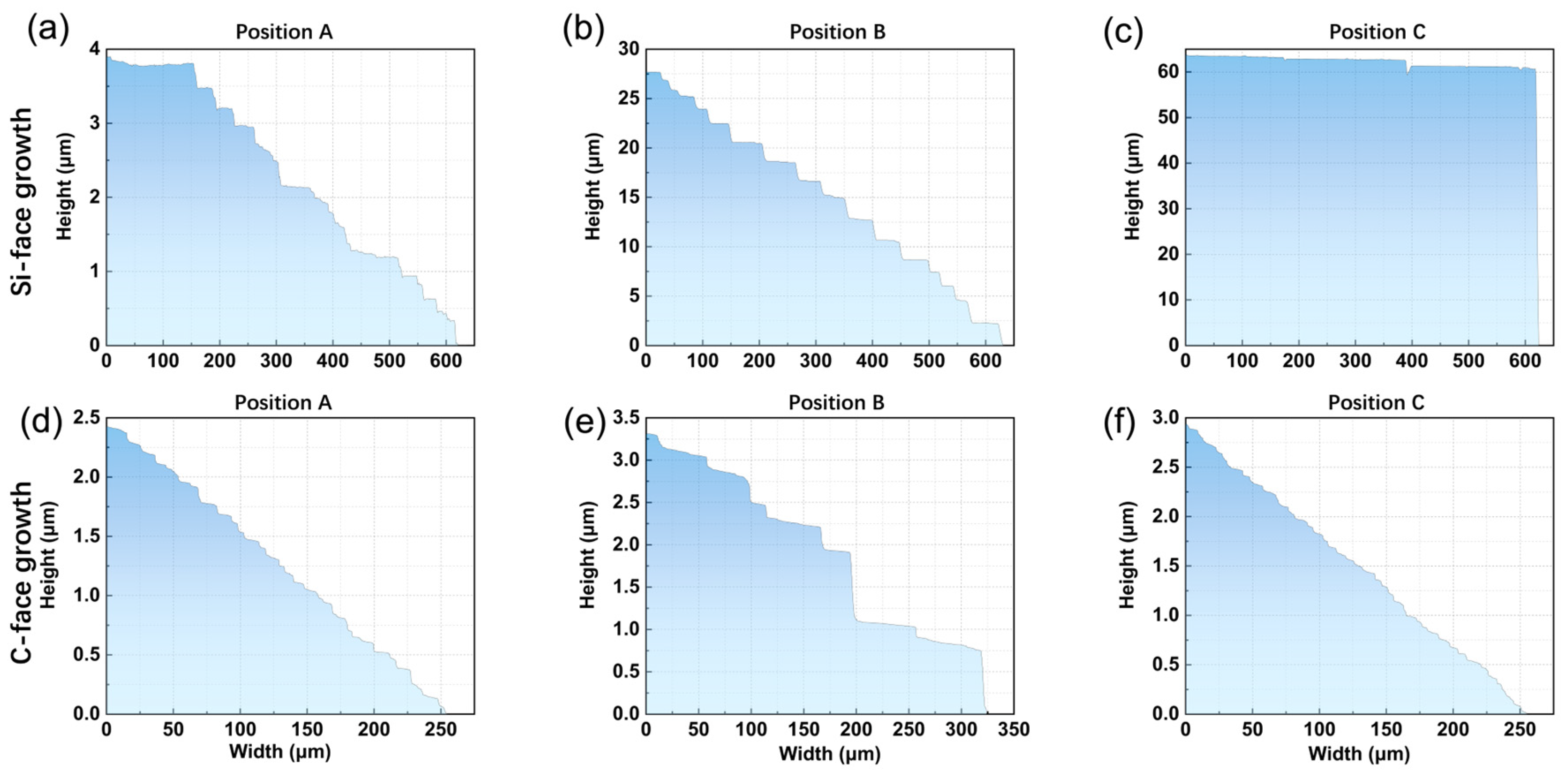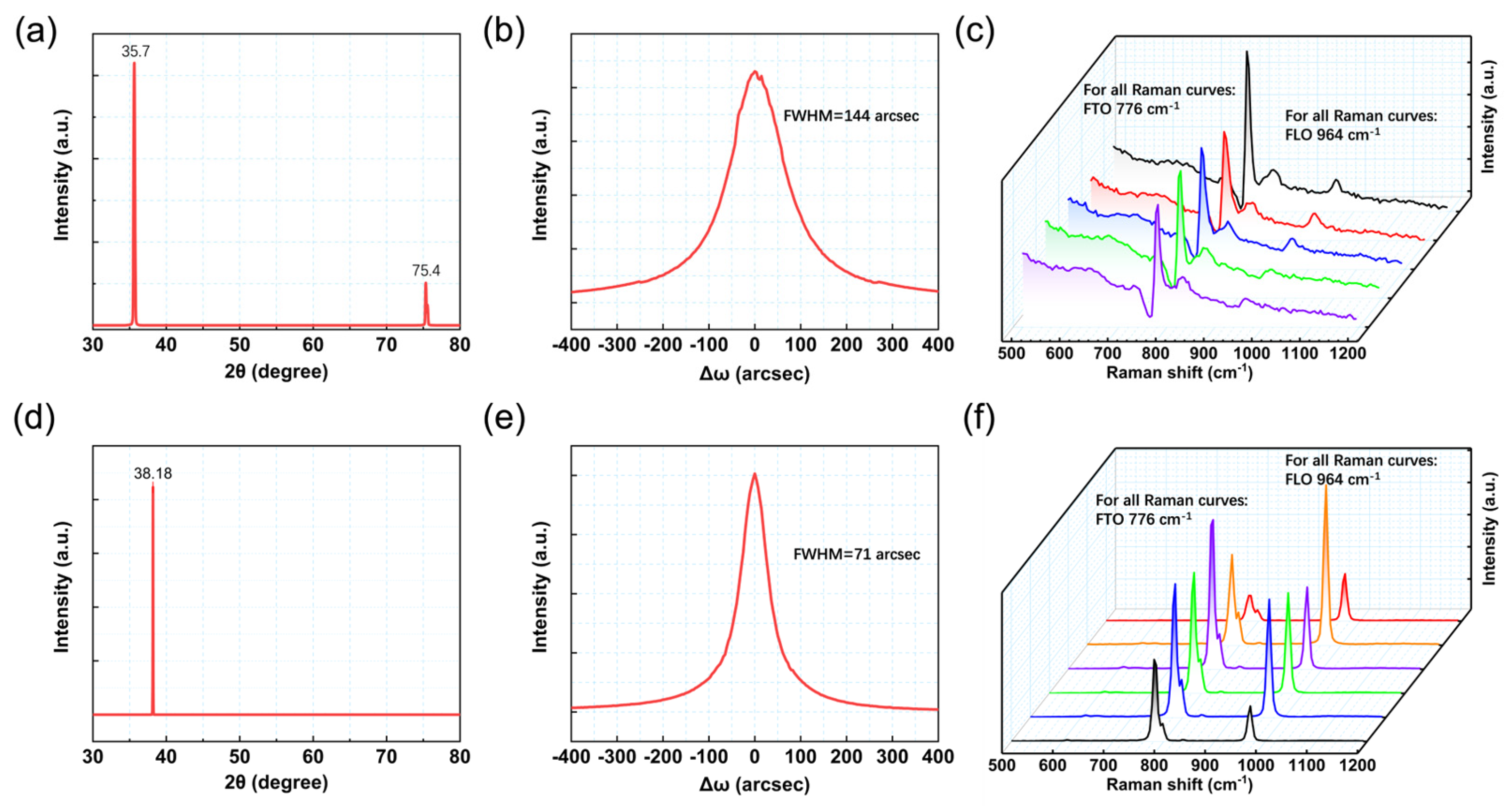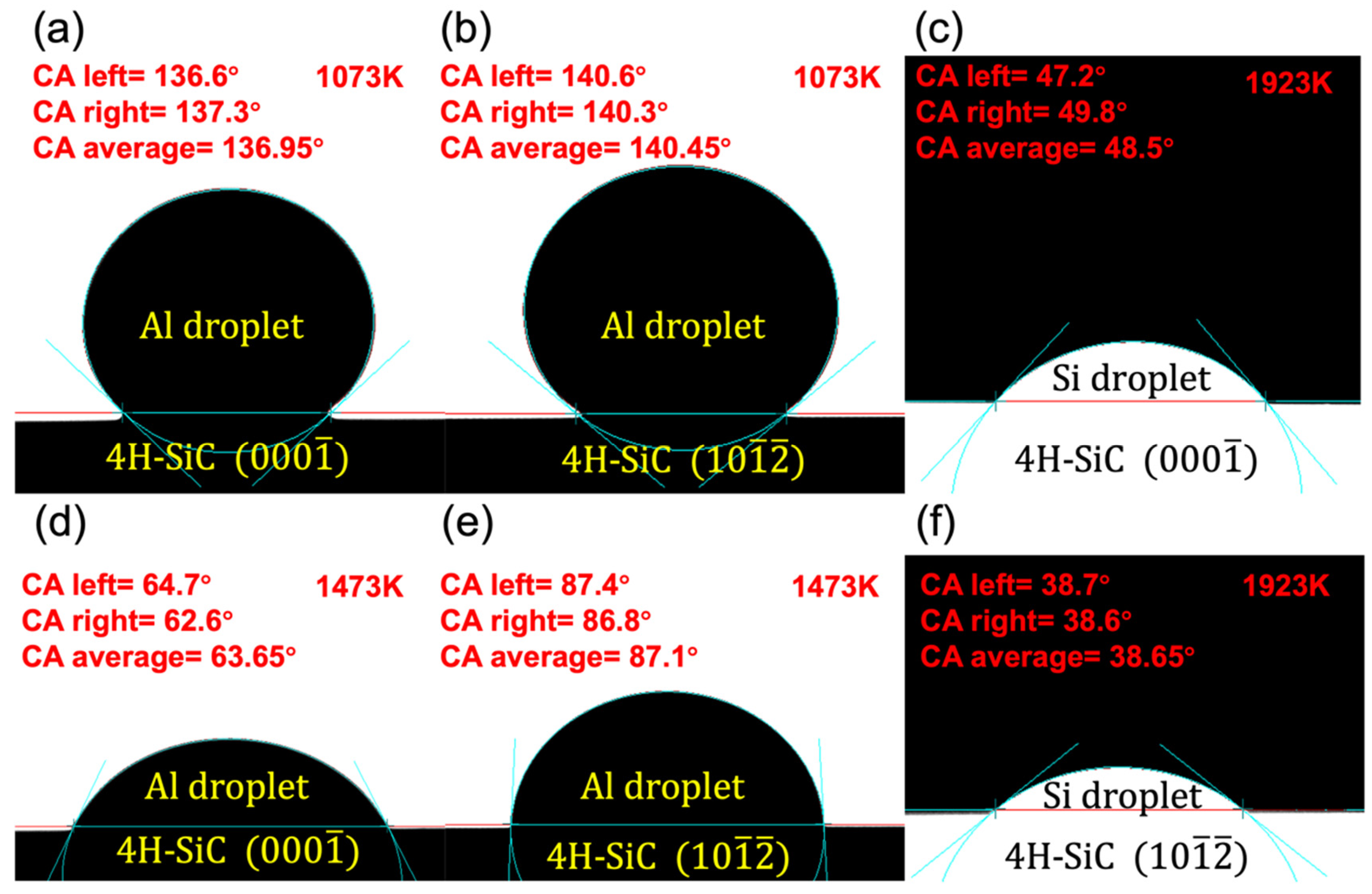Surface Morphology of 6-Inch SiC Single Crystals in Solution Growth on Si-Face, C-Face and (
Abstract
1. Introduction
2. Numerical and Experimental Methods
3. Results and Discussion
3.1. Influence of Si-Face and C-Face on Surface Morphology of On-Axis Grown SiC
3.2. 6-Inch SiC Single Crystals Grown on () Face
4. Conclusions
Author Contributions
Funding
Data Availability Statement
Acknowledgments
Conflicts of Interest
Correction Statement
References
- Kusunoki, K.; Seki, K.; Kishida, Y.; Moriguchi, K.; Kaido, H.; Okada, N.; Kamei, K. Development of High Quality 4H-SiC Single Crystal Wafers Grown by Solution Growth Technique. In Nippon Steel & Sumitomo Metal Technical Report No. 117; Nippon Steel: Chiyoda City, Japan, 2017. [Google Scholar]
- Mitani, T.; Eto, K.; Komatsu, N.; Hayashi, Y.; Suo, H.; Kato, T. Reduction of Threading Screw Dislocations in 4H-SiC Crystals by a Hybrid Method with Solution Growth and Physical Vapor Transport Growth. J. Cryst. Growth 2021, 568–569, 126189. [Google Scholar] [CrossRef]
- Nakamura, D.; Gunjishima, I.; Yamaguchi, S.; Ito, T.; Okamoto, A.; Kondo, H.; Onda, S.; Takatori, K. Ultrahigh-Quality Silicon Carbide Single Crystals. Nature 2004, 430, 1009–1012. [Google Scholar] [CrossRef] [PubMed]
- Takahashi, J.; Kawaguchi, K.; Kusunoki, K.; Ueyama, T.; Kazuhito, K. Tem Studies on the Microstructure of M-Face Grown 4h-Sic by Solution Growth. Mater. Sci. Forum 2020, 1004 MSF, 414–420. [Google Scholar] [CrossRef]
- Fujii, M.; Tanaka, S. Ordering Distance of Surface Nanofacets on Vicinal 4H-SiC(0001). Phys. Rev. Lett. 2007, 99, 016102. [Google Scholar] [CrossRef]
- Mitani, T.; Komatsu, N.; Takahashi, T.; Kato, T.; Harada, S.; Ujihara, T.; Matsumoto, Y.; Kurashige, K.; Okumura, H. Effect of Aluminum Addition on the Surface Step Morphology of 4H-SiC Grown from Si-Cr-C Solution. J. Cryst. Growth 2015, 423, 45–49. [Google Scholar] [CrossRef]
- Wang, G.; Sheng, D.; Li, H.; Zhang, Z.; Guo, L.; Guo, Z.; Yuan, W.; Wang, W.; Chen, X. Influence of Interfacial Energy on the Growth of SiC Single Crystals from High Temperature Solutions. CrystEngComm 2022, 25, 560–566. [Google Scholar] [CrossRef]
- Kato, T.; Kusunoki, K.; Seki, K.; Okada, N.; Kamei, K. Effect of Solution Drift on Crystalline Morphology in the Solution Growth of Off-Axis 4H-SiC Crystals. Mater. Sci. Forum 2016, 858, 65–68. [Google Scholar] [CrossRef]
- Umezaki, T.; Koike, D.; Harada, S.; Ujihara, T. Improvement of Surface Morphology by Solution Flow Control in Solution Growth of SiC on Off-Axis Seeds. Mater. Sci. Forum 2015, 821–823, 31–34. [Google Scholar] [CrossRef]
- Daikoku, H.; Kado, M.; Seki, A.; Sato, K.; Bessho, T.; Kusunoki, K.; Kaidou, H.; Kishida, Y.; Moriguchi, K.; Kamei, K. Solution Growth on Concave Surface of 4H-SiC Crystal. Cryst. Growth Des. 2016, 16, 1256–1260. [Google Scholar] [CrossRef]
- Dang, Y.; Liu, X.; Zhu, C.; Fukami, Y.; Ma, S.; Zhou, H.; Liu, X.; Kutsukake, K.; Harada, S.; Ujihara, T. Modeling-Based Design of the Control Pattern for Uniform Macrostep Morphology in Solution Growth of SiC. Cryst. Growth Des. 2023, 23, 1023–1032. [Google Scholar] [CrossRef]
- Nakanishi, Y.; Kutsukake, K.; Dang, Y.; Harada, S.; Tagawa, M.; Ujihara, T. Analysis of Macrostep Interaction via Carbon Diffusion Field in SiC Solution Growth. J. Cryst. Growth 2024, 631, 127609. [Google Scholar] [CrossRef]
- Daikoku, H.; Kawanishi, S.; Yoshikawa, T. Mechanism of Replicating 4H-SiC Polytype during Solution Growth on Concave Surface. Cryst. Growth Des. 2018, 18, 3820–3826. [Google Scholar] [CrossRef]
- Mitani, T.; Komatsu, N.; Hayashi, Y.; Kato, T.; Okumura, H. Morphological Stability of 4H-SiC Crystals in Solution Growth on {0001} and {10m} Surfaces. J. Cryst. Growth 2017, 468, 883–888. [Google Scholar] [CrossRef]
- Daikoku, H.; Kado, M.; Sakamoto, H.; Suzuki, H.; Bessho, T.; Kusunoki, K.; Yashiro, N.; Okada, N.; Moriguchi, K.; Kamei, K. Top-Seeded Solution Growth of 4H-SiC Bulk Crystal Using Si-Cr Based Melt. Mater. Sci. Forum 2012, 717–720, 61–64. [Google Scholar] [CrossRef]
- Danno, K.; Yamaguchi, S.; Kimoto, H.; Sato, K.; Bessho, T. Trials of Solution Growth of Dislocation-Free 4H-SiC Bulk Crystals. Mater. Sci. Forum 2016, 858, 19–22. [Google Scholar] [CrossRef]
- Sheng, D.; Wang, G.; Yang, Y.; Li, H.; Guo, J.G.; Wang, W.; Chen, X. Modeling and Suppressing Interfacial Instability in Growth of SiC from High-Temperature Solutions. Cryst. Growth Des. 2025, 25, 1211–1216. [Google Scholar] [CrossRef]
- Yamamoto, Y.; Seki, K.; Kozawa, S.; Alexander; Harada, S.; Ujihara, T. Stable Growth of 4H-SiC Single Polytype by Controlling the Surface Morphology Using a Temperature Gradient in Solution Growth. Mater. Sci. Forum 2012, 717–720, 53–56. [Google Scholar] [CrossRef]
- Hayashi, Y.; Mitani, T.; Komatsu, N.; Kato, T.; Okumura, H. Control of Temperature Distribution to Suppress Macro-Defects in Solution Growth of 4H-SiC Crystals. J. Cryst. Growth 2019, 523, 125151. [Google Scholar] [CrossRef]
- Endo, S.; Kamei, K.; Kishida, Y.; Moriguchi, K. Effects of Crystalline Polarity and Temperature Gradient on Step Bunching Behavior of Off-Axis 4H-SiC Solution Growth. Mater. Sci. Forum 2015, 821–823, 26–30. [Google Scholar] [CrossRef]
- Syväjärvi, M.; Yakimova, R.; Janzén, E. Interfacial Properties in Liquid Phase Growth of SiC. J. Electrochem. Soc. 1999, 146, 1565. [Google Scholar] [CrossRef]
- Tran, R.; Xu, Z.; Radhakrishnan, B.; Winston, D.; Sun, W.; Persson, K.A.; Ong, S.P. Data Descriptor: Surface Energies of Elemental Crystals. Sci. Data 2016, 3, 160080. [Google Scholar] [CrossRef] [PubMed]
- Clark, S.J.; Segall, M.D.; Pickard Ii, C.J.; Hasnip, P.J.; Probert, M.I.J.; Refson, K.; Payne, M.C. First Principles Methods Using CASTEP. Z. Krist.-Cryst. Mater. 2005, 220, 567–570. [Google Scholar] [CrossRef]
- Yousefi, E.; Sun, Y.; Kunwar, A.; Guo, M.; Moelans, N.; Seveno, D. Surface Tension of Aluminum-Oxygen System: A Molecular Dynamics Study. Acta Mater. 2021, 221, 117430. [Google Scholar] [CrossRef]
- Nakanishi, H.; Nakazato, K.; Terashima, K. Surface Tension Variation of Molten Silicon Measured by Ring Tensiometry Technique and Related Temperature and Impurity Dependence. Jpn. J. Appl. Phys. 2000, 39, 6487. [Google Scholar] [CrossRef]









| Eslab [eV] | Ebulk [eV] | n | ] | ] | Esurf [J/m2] | |
|---|---|---|---|---|---|---|
| C-face | −5241.82 | −1314.27 | 4 | 33 | 0.2313 | 3.7 |
| () | −5235.36 | −1314.27 | 4 | 71 | 0.1539 | 2.5 |
Disclaimer/Publisher’s Note: The statements, opinions and data contained in all publications are solely those of the individual author(s) and contributor(s) and not of MDPI and/or the editor(s). MDPI and/or the editor(s) disclaim responsibility for any injury to people or property resulting from any ideas, methods, instructions or products referred to in the content. |
© 2025 by the authors. Licensee MDPI, Basel, Switzerland. This article is an open access article distributed under the terms and conditions of the Creative Commons Attribution (CC BY) license (https://creativecommons.org/licenses/by/4.0/).
Share and Cite
Liang, G.; Kuang, J.; Su, Y.; Liu, Y.
Surface Morphology of 6-Inch SiC Single Crystals in Solution Growth on Si-Face, C-Face and (
Liang G, Kuang J, Su Y, Liu Y.
Surface Morphology of 6-Inch SiC Single Crystals in Solution Growth on Si-Face, C-Face and (
Liang, Gangqiang, Jiayi Kuang, Yilin Su, and Yuan Liu.
2025. "Surface Morphology of 6-Inch SiC Single Crystals in Solution Growth on Si-Face, C-Face and (
Liang, G., Kuang, J., Su, Y., & Liu, Y.
(2025). Surface Morphology of 6-Inch SiC Single Crystals in Solution Growth on Si-Face, C-Face and (






